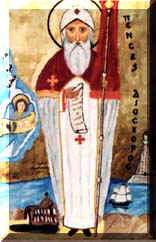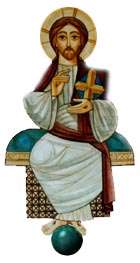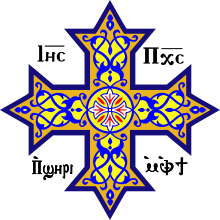Pope Dioscorus I of Alexandria
| Saint Dioscorus the Great The Champion of Orthodoxy | |
|---|---|
| Pope of Alexandria & Patriarch of the See of St. Mark | |
 Coptic icon of St. Dioscorus | |
| Papacy began | 444 |
| Papacy ended | September 454 |
| Predecessor | Cyril "Pillar of Faith" |
| Successor | Timothy II |
| Personal details | |
| Born | Egypt |
| Died | September 454 |
| Buried | Island of Gangra, Paphlagonia |
| Nationality | Egyptian |
| Denomination | Coptic Orthodox Christian |
| Residence | Saint Mark's Church |
| Sainthood | |
| Feast day | 7 Thout in the Coptic Calendar[1] (4 September in the Julian Calendar) (17 September in the Gregorian Calendar [from 1901 to 2099]) |
| Venerated in |
Oriental Orthodox Churches Non-Chalcedonian Miaphysite |
| Shrines | St Mark Cathedral (Cairo, Egypt) |
| Part of a series on |
| Oriental Orthodoxy |
|---|
 |
| Oriental Orthodox churches |
|
Subdivisions
|
|
History and theology
|
|
Major figures
|
|
|
Pope Dioscorus I of Alexandria, 25th Pope of Alexandria & Patriarch of the See of St. Mark. He was deposed by the Council of Chalcedon in 451 but was recognized as Patriarch by the Coptic Church until his death. He died on the Island of Gangra, Paphlagonia, in September 454.[2] He is venerated as a saint by the Coptic and other Oriental Orthodox churches.
Early life
Dioscorus served as the dean of the Catechetical School of Alexandria, and was the personal secretary of Cyril of Alexandria, whom he accompanied to the Council of Ephesus in 431. He eventually rose to the position of archdeacon.[3]
Opposition to Nestorius
In his struggle against Nestorius, Cyril explained the union between the divine and human natures of Christ as "inward and real without any division, change, or confusion." He rejected the Antiochene theory of "indwelling,", or "conjunction" or "close participation," as insufficient. Thus the Alexandrian formula adopted by Cyril and Dioscorus was "one nature of God the Word Incarnate," which translates into Greek as mia physis tou theou logou sesarkomene, by which Cyril meant "one nature"—that Christ is at once God and man. On the other hand, the Antiochene formula was "two natures after the union," or "in two natures," which translates to dyo physis. This formula explained Christ as existing in two natures, God and man.
Nestorius was condemned and deposed by the First Council of Ephesus, which approved of the Second Epistle of Cyril to Nestorius.
Dioscorus succeeded Cyril as Patriarch of Alexandria in 444.[2]
Reception of Eutyches
Dioscorus supported Eutyches, an archmandrite in Constantinople who defended the formula of "one nature" against the formula of dyo physis. A synod chaired by Archbishop Flavian of Constantinople in 448 condemned and exiled Eutyches. Eutyches appealed against this decision, labeling Flavian a Nestorian, and received the support of Dioscorus, while Pope Leo I, in his famous Tome confirmed Flavian's theological position but also requested that Eutyches should be readmitted if he repented.[4]
In 449, Emperor Theodosius II convened the Second Council of Ephesus. In remembrance of Cyril's role during the council of 431, the emperor asked Dioscorus to preside over the meetings. The council subsequently decided to reinstate Eutyches and to depose Flavian, as well as Eusebius of Dorylaeum, Theoderet of Cyrrus, Ibas of Edessa, and Domnus II of Antioch. Leo's legates protested but were ignored.[3] Pope Leo himself called the council a "robber synod" and declared its decisions void.[1]
Theodosius supported the council's decisions until he died on 28 July 450. His sister Pulcheria returned to power and made the officer Marcian her consort and emperor. She consulted with Pope Leo on convoking a new council, gathering signatures for his Tome to be introduced as the basic paper for the new council, but also insisted, against Leo's wishes, that the council should be held not in Italy but in the East. Meanwhile, the new imperial couple brought Flavian's remains back to Constantinople and exiled Eutyches to Syria.
In the council of Chalcedon 451, Dioscorus expressed a willingness to condemn Eutyches. According to the minutes of the council of Chalcedon, Dioscorus stated: "If Eutyches holds opinions contrary to the doctrines of the church, he deserves not only punishment but hell fire. For my concern is for the catholic and apostolic faith and not for any human being."
Council of Chalcedon
The Council of Chalcedon dealt with the Christological views of Eutyches but also with Dioscorus' views and earlier behaviour; specifically, his condemnation of the bishop Flavian in Ephesus II was questioned. When, at the Council of Chalcedon, he was asked why he had deposed Flavian, he, according to the minutes of Chalcedon, responded:
"Flavian was deposed for this reason, that he spoke of two natures after the union. But I have quotations from the holy fathers Athanasius, Gregory and Cyril saying in numerous places that one should not speak of two natures after the union".[5]
Instead, Dioscorus argued:
"that one should not speak of two natures after the union but of one incarnate nature of the Word".[6]
The Council deposed Dioscorus and other bishops that had been responsible for the decisions of 449 for violations of canon law rather than of heresy; Dioscorus had not attended the council of Chalcedon from the third session onward despite an imperial call to do so, which was a deposable offence. According to the minutes of the council of Chalcedon, Dioscorus had given the reason of ill health for his nonattendance from the third session. However, Oriental sources indicate otherwise that it was subterfuge. Whatever the real reason, the result of Dioscorus not being there saw him exiled to Gangra Island.[3][4]
Exile
Following Dioscorus's deposition and exile, an Alexandrian priest named Proterius was appointed Patriarch in his stead, with the approval of the emperor. There was no public opposition to Proterius. Nonetheless, some Christians continued to support Dioscorus in secret, considering him the legitimate Patriarch.
Dioscorus died in exile in 454. When the news reached Egypt, his supporters assembled and elected Timothy, a disciple of his, to be the new Patriarch. Timothy immediately went into hiding, but was recognized among the Coptic inhabitants of the countryside, creating the split between the Coptic and the Melchite (i.e. Imperial) Church.
Legacy
Oriental Orthodox Churches remain in disagreement with Eastern Orthodox and Catholic churches regarding Dioscorus's character and positions. He is considered a saint by the Coptic, Syriac, and other Oriental Orthodox churches, while Eastern Orthodox and Catholic Churches have frequently deemed him a heretic.
Certain modern theologians suggest that both Leo and Dioscorus were orthodox in their agreement with Saint Cyril's Twelve Chapters, even though both have been (and still are) considered heretical by some.[7] Some commentators like Anatolius and John S. Romanides argue that Dioscorus was not deposed for heresy but for "grave administrative errors" at Ephesus II, among which they mention his restoration of Eutyches, his attack on Flavian, and afterwards, his excommunication of Pope Leo I. Defenders of Dioscorus argue that Eutyches was orthodox at the time of his restoration and only later lapsed into heresy, that Flavian was a Nestorian, and that Pope Leo had supported Nestorianism.[7][8]
Another controversial aspect of Dioscorus's legacy is the accusation, frequently levelled by Chalcedonian churches, that the Oriental Orthodox Churches accept Eutychianism. They deny this charge, arguing that they reject both the Monophysitism of Eutyches, whom they consider a heretic, as well as Dyophysitism espoused by the Council of Chalcedon, which they equate with Nestorianism, for a doctrine they term miaphysitism, or that in Jesus Christ, divinity and humanity exist as "one incarnate nature" (physis), as opposed to the orthodox Chalcedonian teaching of a divine and a human nature united in the one person (hypostasis) of Jesus Christ, fully God and fully man, a doctrine called the "hypostatic union".[9]
In recent times, Oriental Orthodox churches have engaged in ecumenical dialogue with Catholic and Eastern Orthodox churches on the issues of Dioscorus's day. In May 1973 Pope Shenouda III of Alexandria visited Pope Paul VI in Rome and declared a common faith in the nature of Christ, the issue which caused the schism of the church in the Council of Chalcedon.[10] A similar declaration was reached between the Oriental and Eastern Orthodox churches in 1990 in Geneva, in which both agreed in condemnation of the Nestorian and Eutychian "heresies" and in rejection of interpretations of ecumenical councils which do not fully agree with the Horos of the Third Ecumenical Council and the letter (433) of Cyril of Alexandria to John of Antioch.[11] They also agreed to lift the anathemas and condemnations of the past.[12] In the summer of 2001, the Coptic Orthodox and Greek Orthodox Patriarchates of Alexandria agreed to mutually recognize baptisms performed in each other's churches.[13]
References
- 1 2 "Commemorations for Tout 7". Coptic Orthodox Church Network. Retrieved 8 January 2013.
- 1 2 Chapman, J. (1909). "Dioscurus". Catholic Encyclopedia. New York: Robert Appleton Company. Retrieved 8 January 2013.
- 1 2 3 Encyclopædia Britannica, Micropædia v. 4, p. 112. Chicago: Encyclopædia Britannica, Inc., 1998. ISBN 0-85229-633-9.
- 1 2 "Coptic interpretations of the Fourth Ecumenical Council" (PDF). Our Lady of Zeitun Online. Retrieved 8 January 2013.
- ↑ Richard Price & Michael Gaddis, The Acts of the Council of Chalcedon, vol. 1 (Liverpool University Press, 2005; ISBN 0-85323-039-0), p. 190
- ↑ Price & Gaddis, p. 185
- 1 2 Romanides, John S. (1994). "Orthodox and Oriental Orthodox Consultation". Romanity.org. Retrieved 29 December 2012.
- ↑ Bishop Angaelos, H.G. "The Altar in the Midst of Egypt". Coptichymns.net. Archived from the original on 29 June 2012.
- ↑ Davis, SJ, Leo Donald (1990). The First Seven Ecumenical Councils (325–787): Their History and Theology (Theology and Life Series 21). Collegeville, MN: Michael Glazier/Liturgical Press. p. 342. ISBN 978-0-8146-5616-7. OCLC 21906084.
- ↑ Mikhail, Mikhail E. (2012). "His Holiness Pope Shenouda III". Coptic Orthodox Church Network. Retrieved 8 January 2013.
- ↑ "Second Agreed Statement". Orthodox Unity. 1990. Archived from the original on 7 February 2012.
- ↑ "Notes" (PDF). Our Lady of Zeitun Online. Retrieved 8 January 2013.
- ↑ "Church of Alexandria (Coptic)". Orthodox Wiki. Retrieved 8 January 2013.
Sources
- Meyendorff, John (1989). Imperial unity and Christian divisions: The Church 450-680 A.D. The Church in history. 2. Crestwood, NY: St. Vladimir's Seminary Press. ISBN 978-0-88-141056-3.
- St. Dioscorus, 25th Pope of Alexandria.
| Titles of Early Christianity | ||
|---|---|---|
| Preceded by Cyril I |
Pope and Patriarch of Alexandria (before schism) 444–451 |
Succeeded by Proterius I |
| Coptic Orthodox Pope of Alexandria 444–454 |
Succeeded by Timothy II | |
